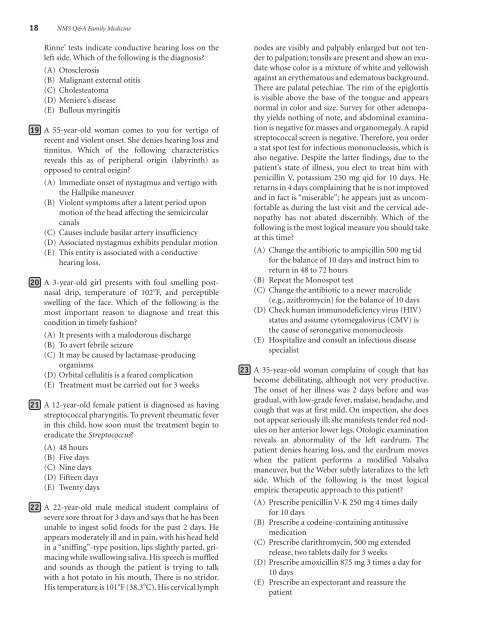NMS Q&A Family Medicine
NMS Q&A Family Medicine
NMS Q&A Family Medicine
- No tags were found...
You also want an ePaper? Increase the reach of your titles
YUMPU automatically turns print PDFs into web optimized ePapers that Google loves.
18 <strong>NMS</strong> Q&A <strong>Family</strong> <strong>Medicine</strong>Rinne’ tests indicate conductive hearing loss on theleft side. Which of the following is the diagnosis?(A) Otosclerosis(B) Malignant external otitis(C) Cholesteatoma(D) Meniere’s disease(E) Bullous myringitis19 A 55-year-old woman comes to you for vertigo ofrecent and violent onset. She denies hearing loss andtinnitus. Which of the following characteristicsreveals this as of peripheral origin (labyrinth) asopposed to central origin?(A) Immediate onset of nystagmus and vertigo withthe Hallpike maneuver(B) Violent symptoms after a latent period uponmotion of the head affecting the semicircularcanals(C) Causes include basilar artery insufficiency(D) Associated nystagmus exhibits pendular motion(E) This entity is associated with a conductivehearing loss.20 A 3-year-old girl presents with foul smelling postnasaldrip, temperature of 102 F, and perceptibleswelling of the face. Which of the following is themost important reason to diagnose and treat thiscondition in timely fashion?(A) It presents with a malodorous discharge(B) To avert febrile seizure(C) It may be caused by lactamase-producingorganisms(D) Orbital cellulitis is a feared complication(E) Treatment must be carried out for 3 weeks21 A 12-year-old female patient is diagnosed as havingstreptococcal pharyngitis. To prevent rheumatic feverin this child, how soon must the treatment begin toeradicate the Streptococcus ?(A) 48 hours(B) Five days(C) Nine days(D) Fifteen days(E) Twenty days22 A 22-year-old male medical student complains ofsevere sore throat for 3 days and says that he has beenunable to ingest solid foods for the past 2 days. Heappears moderately ill and in pain, with his head heldin a “sniffing”-type position, lips slightly parted, grimacingwhile swallowing saliva. His speech is muffledand sounds as though the patient is trying to talkwith a hot potato in his mouth. There is no stridor.His temperature is 101 F (38.3 C). His cervical lymphnodes are visibly and palpably enlarged but not tenderto palpation; tonsils are present and show an exudatewhose color is a mixture of white and yellowishagainst an erythematous and edematous background.There are palatal petechiae. The rim of the epiglottisis visible above the base of the tongue and appearsnormal in color and size. Survey for other adenopathyyields nothing of note, and abdominal examinationis negative for masses and organomegaly. A rapidstreptococcal screen is negative. Therefore, you ordera stat spot test for infectious mononucleosis, which isalso negative. Despite the latter findings, due to thepatient’s state of illness, you elect to treat him withpenicillin V, potassium 250 mg qid for 10 days. Hereturns in 4 days complaining that he is not improvedand in fact is “miserable”; he appears just as uncomfortableas during the last visit and the cervical adenopathyhas not abated discernibly. Which of thefollowing is the most logical measure you should takeat this time?(A) Change the antibiotic to ampicillin 500 mg tidfor the balance of 10 days and instruct him toreturn in 48 to 72 hours(B) Repeat the Monospot test(C) Change the antibiotic to a newer macrolide(e.g., azithromycin) for the balance of 10 days(D) Check human immunodeficiency virus (HIV)status and assume cytomegalovirus (CMV) isthe cause of seronegative mononucleosis(E) Hospitalize and consult an infectious diseasespecialist23 A 35-year-old woman complains of cough that hasbecome debilitating, although not very productive.The onset of her illness was 2 days before and wasgradual, with low-grade fever, malaise, headache, andcough that was at first mild. On inspection, she doesnot appear seriously ill; she manifests tender red noduleson her anterior lower legs. Otologic examinationreveals an abnormality of the left eardrum. Thepatient denies hearing loss, and the eardrum moveswhen the patient performs a modified Valsalvamaneuver, but the Weber subtly lateralizes to the leftside. Which of the following is the most logicalempiric therapeutic approach to this patient?(A) Prescribe penicillin V-K 250 mg 4 times dailyfor 10 days(B) Prescribe a codeine-containing antitussivemedication(C) Prescribe clarithromycin, 500 mg extendedrelease, two tablets daily for 3 weeks(D) Prescribe amoxicillin 875 mg 3 times a day for10 days(E) Prescribe an expectorant and reassure thepatient
















